Rule the Open Road!
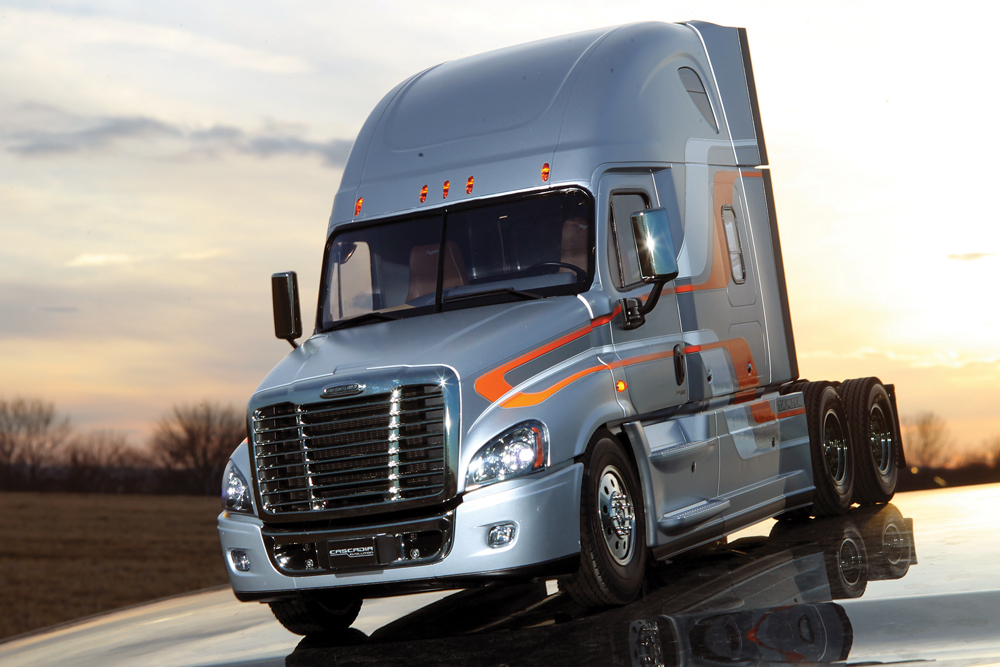
Words: Greg Vogel
Photos: Walter Sidas
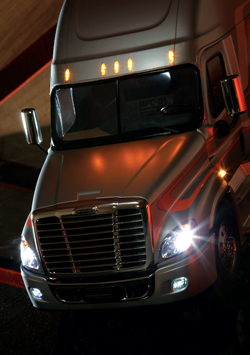
The radio control hobby started off as an evolution of static modeling and Tamiya has been the leader in radio control modeling since the beginning. Over the years, they never lost sight of the true modeling aspect and many of their kits offer you the full experience of building, painting and driving a near replica of a full-scale machine. The series that really stands out as an epic modeling experience is Tamiya’s line of tractor trailers and they’ve just added an absolutely stunning kit to their offerings. Tamiya teamed up with Freightliner to recreate the Cascadia Evolution on a smaller scale and did they ever deliver! Tamiya captured the sleek aerodynamic lines that make the Cascadia such an important transport vehicle in the real world, focusing on improving fuel economy and lessening the environmental footprint of trucking. We all see these majestic machines on the roads every day, now is your opportunity to get behind the wheel of your own.
AT A GLANCE
WHO MAKES IT: Tamiya
WHO IT’S FOR: Any RC enthusiast
HOW MUCH: $470
BUY: CLICK HERE
BUILD TYPE: Kit
PROS
• Fully licensed scale replica Freightliner body with amazing detail
• Three-speed transmission is great for scale speed operation
• Detailed seats and dashboard look cool when peering into the window
• The leaf-spring suspension is just too cool
• Awesome hobby modeling experience
CONS
• No bearings; in this day and age, all kits should have a complete set of ball bearings
REVIEWER’S OPINION
Tamiya has once again delivered on the true modeling experience. The Freightliner Cascadia is an awesome building experience. The instructions are well detailed, the parts are easy to locate and assemble and the quality for the model’s intended use is spot-on. The truck is topped off with a beautiful scale body that you have to paint and detail and when it’s done; trust me, you’ll be left with pure satisfaction with the results.
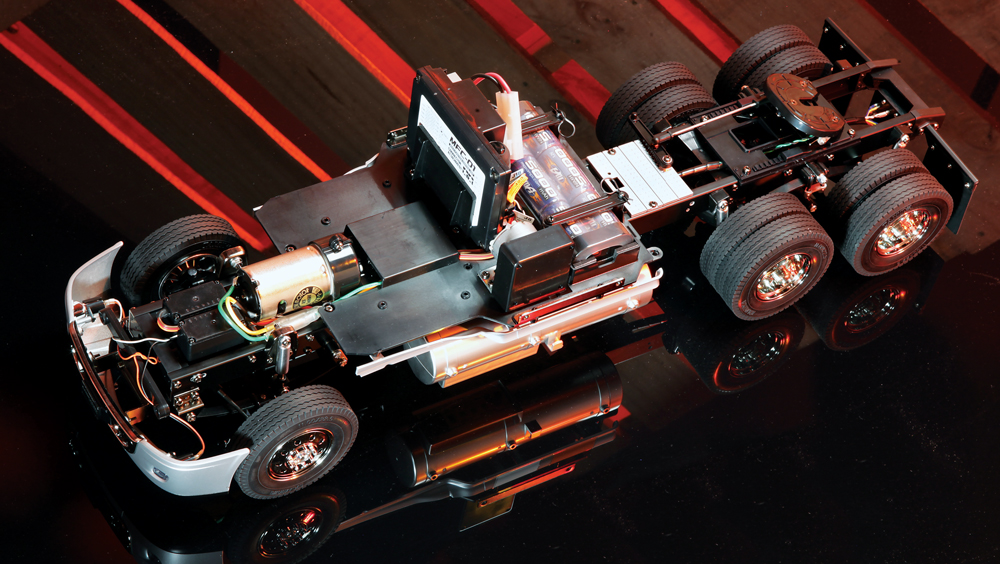
FACTS
• The frame of the Cascadia is based off two black anodized aluminum channel rails with a series of cross members to tie everything together. At the rear of the chassis is the rear tie-bulkhead with reverse light housing and taillight housings. You’ll also notice in the rear that two mud-flap support beams span out to support authentic-looking rubber mud-flaps complete with metal plate retainers and Freightliner logo decals. Above the rails in the rear is the truck’s fifth wheel coupling where the trailer hitches. It’s spring loaded to fall flat when mating up with a trailer. There is also a quick release lever to unhook the trailer and if you equip your rig with the MFC, a micro switch in the hitch actuates the sounds of the hitching/unhitching process.
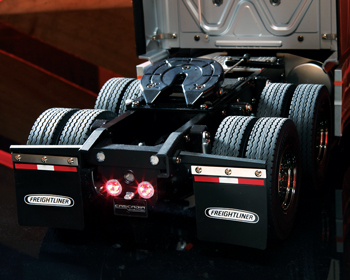
• The suspension system is derived from that of a real rig. Up front, leaf springs and shackles attach to the suspension cross beam where the steering spindles attach. An aluminum shock on each side features a spring inside for rebound, but there is no damping nor is it really necessary. The rear also features a leaf spring and shock suspension setup with mini-swing arms to keep the rear axles from rotating. Lots of the brackets on the suspension components are stamped metal, which is where the real quality of the kit shows. When building the leaf springs with the u-bolts and plates, you get a real appreciation for the engineering that went into this kit.
• The transmission starts with a huge center gearbox assembly that makes up the three speed transmission. The transmission is made up of a number of gears and shift forks to move the gears in place for low, medium and high gear. The gearbox assembly is supported by aluminum cross tubes and an aluminum endplate which the included 540 motor mounts to. The one thing noticeably absent from the build was ball bearings, only bronze bushings and one bearing in total were included. Power from the tranny goes to the rear forward axle via a long aluminum driveshaft. The forward axle has an input shaft for the long axle and a rear output that sends power to the rear axle via a stubby dogbone and steel drive cups.
• Other than the mentioned motor, there are no electronics included with the kit. The kit requires a 4-channel analog trim radio and Tamiya’s new Attack 2.4GHz offering is perfect for the kit. You’ll also need two servos, one for steering and one for shifting as well as an ESC or Tamiya MFC unit and a battery to complete the package.
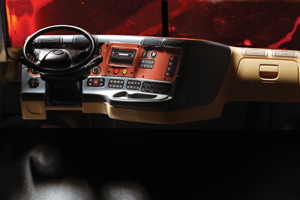
• In the box you’re going to see lots of rubber big rig type truck tires and a matching number of chrome plated rims for them to mount to. The rear dually rims need to be bolted together before being installed. Then, moving back to the chassis area, a large plate over the transmission features a battery cradle in the rear with two straps held in place with body clips to secure the battery. Towards the front, two seats are glued to risers to complete the look later on when the body is installed.
• Finally, let’s talk some details and the big draw of this kit, the Freightliner Cascadia Evolution body set. If you think this body is one piece, two or even three pieces, you are way far off. Painting and assembling the body probably takes more time than building the chassis. The body is made up of the main cab section with a separate bumper, upper cab wind deflector, rear wind panels, lower skirt panels and a number of other filler plates, all of which should be primed and then painted the final color. The grille, lower bumper grille, mirrors and headlight housings are all chrome-plated plastic for a really cool finish once the truck is complete. Even the side step plates are satin plated and look fantastic. The mirrors once assembled swivel in their brackets, which are secured with small Allen screws. The headlight housings are covered with clear plastic lenses and LED’s can be secured in place from the backside for those times you’ll be hauling at dusk. A crystal clear plastic windshield and windows bolt in or glue into place for an authentic look and behind them is a scaled down version of a Cascadia dashboard, complete with gauge decals and even a steering wheel atop a steering column. Tinted red and amber lenses are used for marker and brake lights and fog lights are set into the lower bumper. Basically any and all detail found on the real Cascadia has been scaled down and replicated on the model. After plenty of painting and detailing, you can determine if your rig needs decals and if so, Tamiya includes some authentic Freightliner graphics that are used on some of the real demo Cascadia rigs.
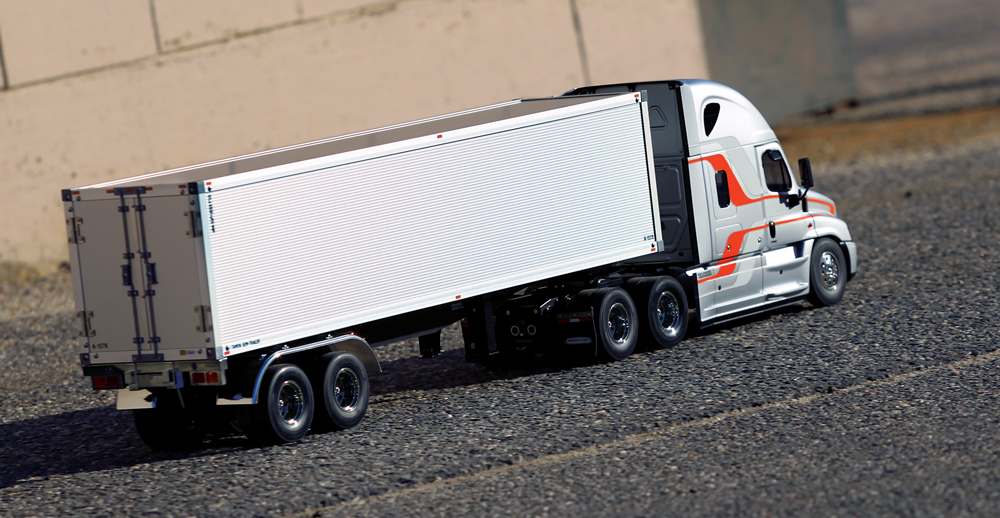
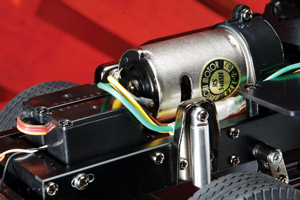
TOOLS & ACCESSORIES INCLUDED
• Allen wrenches, box wrench, mini-Phillips screwdriver and thread locking compound.
ITEMS NEEDED
• 4-channel surface radio and receiver with analog trims
• Electronic speed control or Tamiya MFC Unit
• 7.4V NiMh battery pack and charger
ITEMS USED
• Tractor Truck Multi-Function Control Unit,56511
The kit does not come with a speed control, so if you are on a budget, grab yourself a Tamiya TEU-302BK ESC for throttle duty. If budget is not an issue, do yourself a favor and get the MFC, it controls the throttle as well as the MFC included lights, a speaker and vibration unit that makes this truck come alive with authenticity.
• Tamiya Attack 2.4GHz Radio, 7255252
The radio options for this truck are limited since it needs a 4-channel analog trim radio to work with the MFC. Tamiya is now importing this 2.4GHz radio and it works perfectly on all of their tractor trailer offerings.
• MaxAmps.com 5000mAh NiMH battery
pack. The more capacity you can stuff in the battery cradle, like our 5000mAh pack, the longer run times you’ll get.
ADDITIONAL ITEMS USED
• Tamiya Paint- You’ll need a number of different cans of spray paint to complete the truck, the instructions give details on what accent colors to purchase with the proper Tamiya paint codes.
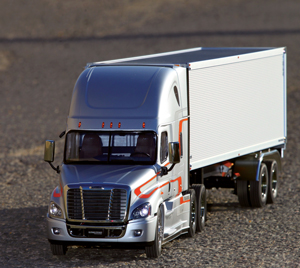
OUT TO PLAY
After a long, long build time, I’m guessing well over eighty hours since I lost track along the way, it was finally time to drive this truck out on the open road, or more specifically a place with no real car traffic. There have been very few times where I had reservations about driving an RC vehicle and this was one. For the amount of time I put into the build and the total cost of the project, it got my adrenaline going, but I set out to try the action first hand. This truck was built to drive and drive it I did.
My first experience with the truck was on top of our parking garage at the RCD offices. With the radio turned on, I turned on the MFC switch and was instantly startled as the truck “started” up in my hands with the actual engine sounds and vibrating; I was lucky I didn’t drop the truck. I messed around with the lighting button on the MFC and lit up all the lights to run. This thing looked cool! I placed the Cascadia on the ground and then pulled out the trailer from my SUV and set it down. Now it was time to load up to go.
The Tamiya Attack radio was easy to use, but since I started racing with a stick radio I have a good feel for the controls. I backed up the truck toward the trailer and carefully aligned the fifth-wheel coupler with the pin on the trailer. I backed into the pin and it hitched and the trailer support legs shot up into their raised position. At this time I looked up at everyone watching me and simply said, “That was freakin’ cool!”
With the trailer hitched I was ready to truck around town, or at least drive around the top of the garage. A push forward on the throttle stick and the engine sound revved up and the Cascadia was off at a perfect speed for cruising. By just pushing straight up, the truck’s transmission stays in middle gear, which is good for all-around driving. For slower speeds, you drop the throttle to neutral, move the stick to the left and then proceed with forward throttle. This runs the truck in low gear for slow, precise movement. If the throttle stick is moved to the left and then into forward, then it’s in high gear for faster speeds. The faster speeds can be pretty quick for this high-CG truck, so make extra certain you slow down before cranking the steering stick to turn. It felt like it was on the edge of rolling over. The gear selection works the same for reverse, although I never found the need to try high-speed reverse maneuvers; I’m not Cletus from Smokey and the Bandit.
The truck steers so well I would say it’s almost scale. The suspension on the rig is pretty stiff, so you’ll get some bounce and jittering as you run over uneven pavement. The sounds, the lights and the driving experience were all very cool and the Freightliner Cascadia Evo flat out looks so awesome driving back and forth on the lot.
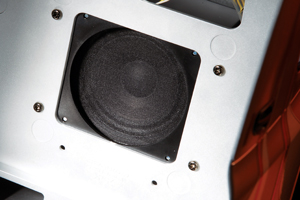
SPECS & TUNING OPTIONS
DIMENSIONS
LENGTH: 25.5 in. (648mm)
WIDTH: 7.7 in. (195mm)
HEIGHT: 12.1 in. (308mm)
BODY, WHEELS AND TIRES
BODY: ABS Plasic Scale Freightline Cascadia Evolution
WHEELS: Chrome plated truck style
WHEEL ADAPTER TYPE: 12mm rear, bearing front
TIRES: Big rig road tire
SUSPENSION
TYPE: Leaf spring
SHOCKS: Aluminum with inner rebound spring
STEERING
TYPE: Direct Link w/servo saver on servo
TOE: Adjustable
CHASSIS
TYPE: Channel rails
MATERIAL: Aluminum
DRIVETRAIN
TYPE: RWD
TRANSMISSION: 3-speed selectable
DIFFERENTIAL: Metal bevel gear with grease
GEAR RATIO: Low Gear 1:32.49, 2nd Gear 1:17.66, 3rd Gear 1:10.66
BEARINGS: Metal bushings w/one bearing in the transmission

TRAILER TALK
Tamiya offers a number of trailer kits like a flatbed trailer, reefer trailer, pole trailer, tanker trailer and the classic semi-trailer; all in kit form of course. We opted to go with the semi-trailer; what did you think we were going to do, drag some tin cans on a string behind the Evo? The trailer is made of two frame plates that attach to leaf springs, shocks and hollow axles for rear wheel support. A leg kit is spring loaded and pops up out of the way once the trailer hitches onto the rig. The box part of the trailer is made out of several flat and some stamped aluminum plates. Milled aluminum channels form the basic outer structure of the box that the plates slide into. Rear doors for the trailer must be assembled and when done, are fully operational by opening and closing and they can be locked in place. If you are interested in enhancing the look of your Cascadia, consider the semi-trailer kit, part number 56302.
WRAP UP
If you’ve been looking for a fun RC experience, than look no further; Tamiya’s Freightliner Cascadia Evolution is a functioning work of scale art. Tamiya really needs to be commended on the true passion they have and offer to the hobby. They are often criticized when producing a large number of scale or fun kits and few race machines. But the high-end racer is not what Tamiya is about; it’s the modeling experience. It’s sitting down in the comfort of your home with a kit and some tools and creating something with your hands, then detailing it and taking pride in your work and enjoying the product of your labor outside in whatever part of nature is in front of you. That is exactly what the Cascadia did for me; it brought me back to the element of purely having fun and enjoying RC. The Cascadia will be among the RC vehicles that I will keep for the rest of my life. Not only did I build it, I built memories I will forever enjoy.
LINKS
MaxAmps maxamps.com
Tamiya tamiyausa.com
 RC Driver The Best In RC Car & Truck News, Reviews & Video
RC Driver The Best In RC Car & Truck News, Reviews & Video 







